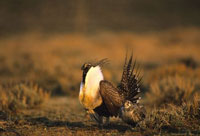Nevada-California Ranchers to Benefit

Strutting Male Sage Grouse with Female
Agriculture Secretary Tom Vilsack today announced a ground-breaking commitment from the U.S. Department of Agriculture (USDA) to accelerate and focus conservation efforts that will benefit ranchers and also the distinct population of greater sage-grouse population that lives along the border of Nevada and California. The bi-state population of sage-grouse is being considered for protection under the Endangered Species Act.
“With proactive conservation investments, we’re helping farmers and ranchers who are improving habitat through voluntary efforts to stabilize this population of sage-grouse,” said Vilsack. “Through action such as this, along with the support of our partners, we can help secure this species’ future and maintain our vibrant western economies.”
USDA will provide up to $25.5 million of conservation investments over the next five to ten years as part of its contribution to delivering the federal, state and local 2012 Bi-State Action Plan, a conservation strategy that will benefit the sage-grouse population in both states. The plan, sanctioned by the Department of the Interior’s U.S. Fish and Wildlife Service (USFWS), aims to focus resources on cost effective and efficient solutions that could avert the need to list the bi-state population as “threatened” or “endangered” under the Endangered Species Act.
Today, the Bureau of Land Management (BLM) also announced a $6.5 million commitment over the next ten years to implement a wide range of priority conservation activities on the public lands it manages to improve sage-grouse habitat. The BLM is coordinating with the U.S. Forest Service to amend resource management plans that will include standards and guidelines designed to conserve and enhance sage grouse habitat.
“We have made it a high priority to engage in voluntary partnership with ranchers, farmers and other landowners to conserve the wildlife and habitat that are so important to our heritage and way of life,” said Secretary of the Interior Sally Jewell. “I applaud the NRCS, USFS and the BLM for their very significant commitments, which will help provide certainty that important conservation actions in key areas of the bird’s habitat will continue to be implemented. Together, we can make our landscapes work for both agriculture and the bi-state sage-grouse.”
The U.S. Forest Service and Natural Resources Conservation Service (NRCS), both USDA agencies, are leading the Sage-Grouse Initiative (SGI) and will have the means to fully carry out conservation practices and policy changes agreed upon by the Bi-State Local Area Working Group in its action plan.
The announcement comes at the conclusion of an extended public comment period on the USFWS proposal to federally list the bi-state population of greater sage-grouse as a threatened species. A final decision on the proposal is expected by April 28, 2015.
Since 2010, USDA has funded $27.5 million of conservation efforts, primarily through working with farmers, ranchers and other land managers in on-the-ground projects that address critical threats identified in the action plan. Conservation easements on private lands are keeping working ranches intact that provide important wetlands for growing sage-grouse broods. Removal of conifers that have invaded sagebrush-steppe is restoring sage-grouse habitat on private and public lands.
The Bi-State Executive Oversight Committee estimates it will cost about $38 million more to fully implement the remaining priority actions identified in the action plan for California and Nevada. The U.S. Forest Service and NRCS will provide over 80 percent of that estimated need under the new agreement with a focus on high impactful projects.
The Sage-Grouse Initiative teams up with partners in 11 western states to achieve wildlife conservation through sustainable ranching. From 2010 to 2013, the initiative enrolled more than 950 ranches and conserved 6,000 square miles through NRCS investments of $247 million that generated $107 million in partners’ matching funds for a total of $354 million of on-the-ground sage grouse conservation.
To view the bi-state letter and detailed implementation plans for bi-state sage grouse conservation, please visit: http://www.nrcs.usda.gov/wps/portal/nrcs/detailfull/national/programs/initiatives/?cid=steldevb1027671
Today’s announcement was made possible by the 2014 Farm Bill. The Farm Bill builds on historic economic gains in rural America over the past five years, while achieving meaningful reform and billions of dollars in savings for taxpayers. Since enactment, USDA has made significant progress to implement each provision of this critical legislation, including providing disaster relief to farmers and ranchers; strengthening risk management tools; expanding access to rural credit; funding critical research; establishing innovative public-private conservation partnerships; developing new markets for rural-made products; and investing in infrastructure, housing and community facilities to help improve quality of life in rural America. For more information, visit www.usda.gov/farmbill









